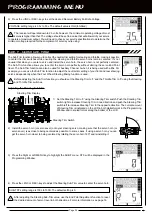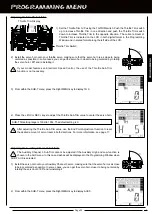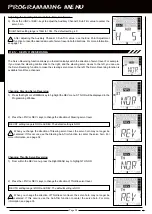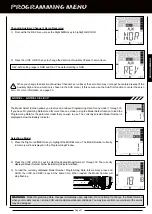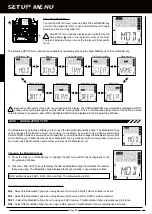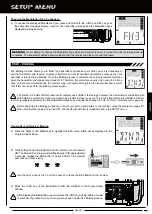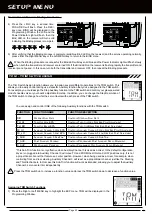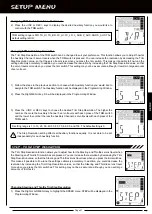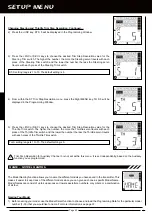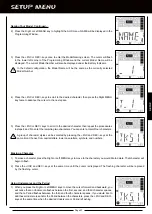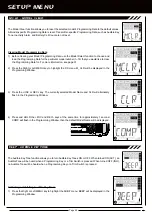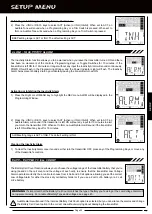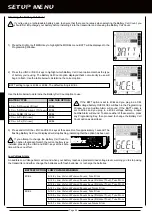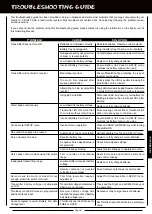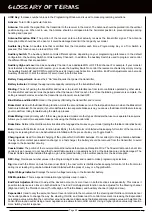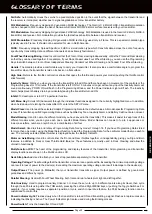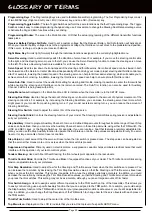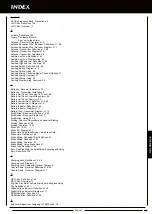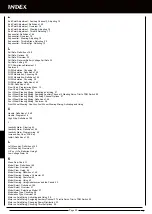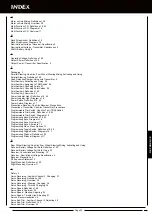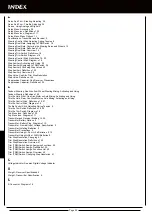
Page 48
gLOSSaRY OF TERMS
+/INC Key:
Increases number values in the Programming Window and is used to make programming selections.
Activate:
To turn ON a particular function.
Antenna:
Transmits the signal from the transmitter to the receiver in the model.
The Antenna should be pivoted into the vertical
position during use. When not in use, the Antenna should be collapsed into the horizontal position to prevent damage during
handling and transport.
Antenna Reception Wire:
The portion of the receiver antenna that actually receives the transmitter signal. The Antenna
Reception Wire should never be bent or it could be damaged and limit the range of your model.
Audible Key Tone:
An audible tone that is emitted from the transmitter each time a Programming Key or a Trim Switch is
pressed. This function can be turned ON or OFF.
Auxiliary Switch:
The Auxiliary Switch controls different options, depending on your programming preferences. In the default
configuration, the Auxiliary Switch controls Auxiliary Channel 3. In addition, the Auxiliary Switch is used to program and control
the different Mixes that are available.
Auxiliary High and Low:
Used as an Auxiliary Channel 3 as a dedicated ON or OFF third channel. For example, if your monster
truck features a transmission with reverse, you can use the Auxiliary Switch to control the reverse mechanism by simply moving
the Auxiliary Switch UP and DOWN to control the servo's travel in each direction. In addition, End Point Adjustments can be made
Auxiliary Channel 3 to limit the amount of servo travel in both directions.
Battery Compartment:
Houses the 4 'AA' Alkaline cells that power the transmitter.
Battery Indicator:
Displays the approximate capacity remaining of the transmitter battery.
Binding:
The act of pairing the transmitter and receiver to prevent interference from radio controllers operated by other users.
The transmitter and receiver must be paired so that the two can 'talk' to each other. Once the Binding procedure is complete, the
setting is remembered even when the transmitter and receiver are turned OFF.
Bind Button and Bind LED:
Used in the process of Binding the transmitter and receiver.
Brake Hold:
Used with the Brake Mixing function. Holds
the second brake servo in the last position it was in when the Brake Hold
function is Activated. For example, if your model features two separate brake servos, you can use the Brake Hold feature to keep
your model from rolling forward during the start-up process.
Brake Mixing:
Used primarily with 1/5th scale gas-powered models or other types of models that use two separate brake servos.
Allows you to control two separate brake servos using the throttle control stick.
Brake Side:
Refers to the throttle control stick stroke that engages the brakes on your model (pulling the throttle control stick back).
Burn:
Used with the Motor on Axle function (dual ESCs), the front motor is inhibited while keeping full control of the rear motor
during rock crawling. Burn can be Activated and Inhibited with the press of a key or a Toggle Switch.
Charging Jack:
Used for onboard charging of the optional Ni-Cd or Ni-MH batteries.
Do not attempt to charge Alkaline batteries.
If using an after-market peak-detection charger or a fast charger, the battery should be removed from the transmitter to avoid
damage to the transmitter circuitry.
Coaxial Cable:
The portion of the receiver antenna that extends the Antenna Reception Wire. The Coaxial Cable can be bent into
gentle curves, however, do not bend the Coaxial Cable acutely, or repeatedly bend it, or the antenna core can be damaged. The
Coaxial Cable should be installed through a nylon tube (antenna tube) in the vertical position for the best reception.
DEC/- Key:
Decreases number values in the Programming Window and is used to make programming selections.
Dig:
Used with the Motor on Axle function (dual ESCs), the rear motor is inhibited while keeping full control of the front motor
during rock crawling. Dig can be Activated and Inhibited with the press of a key or a Toggle Switch.
Digital Voltage Indicator:
Displays the current voltage remaining in the transmitter battery.
DS2 Modulation:
This is a special modulation type typically used in Japan.
End Point Adjustment:
Used to adjust the desired amount of servo travel in both directions independently. This makes it
possible to balance servo travel in both directions. The End Point Adjustment function can be adjusted for the Steering channel
(Right and Left), the Throttle channel (Throttle High and Throttle Brake), and Auxiliary channel 3 (High and Low).
Exponential:
Used to vary the amount of servo travel in relation to the movement of the steering and throttle control sticks near
the neutral positions to change the way the steering, throttle, and brake react to control movement. Increasing the Exponential
percentage value will soften the control feel around neutral and decreasing the Exponential percentage value will heighten the
control feel around neutral. Using a lower negative value allows for smoother control. Using a higher positive value may result in
more 'twitchy' control response.
Summary of Contents for Gemini X
Page 1: ...Page 1 ...
Page 55: ...Page 55 NOTES ...

